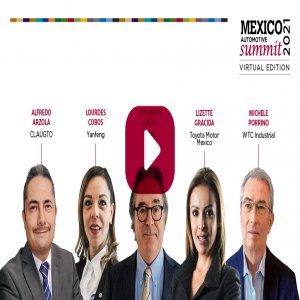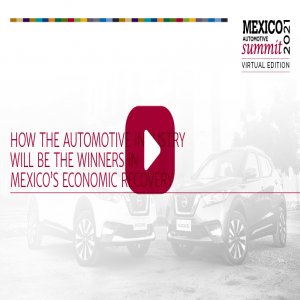
Mexico, North America: Key Destinations for Asian Investment
 By Miriam Bello | Senior Journalist and Industry Analyst -
Thu, 03/25/2021 - 16:40
By Miriam Bello | Senior Journalist and Industry Analyst -
Thu, 03/25/2021 - 16:40
You can watch the video of this panel here.
COVID-19 exposed the fragility of global supply chains. OEMs have reevaluated the benefits of having most suppliers closer to where production operations are, while Tier 1s evaluate all the necessary measures to avoid supply disruptions, including relocating operations to a specific region. Nearshoring, the buzzword for regionalization trends, implies relocating production closer to where large consumer markets are. With USMCA's new rules of origin for automotive goods in place, there is no better timing for foreign companies to transfer operations to North America. All these subjects were discussed during the panel, “From Global to Local: Promising Destinations for Asian Investments In Mexico and North America,” at Mexico Automotive Summit 2021 on Thursday, Mar. 25.
Alfredo Arzola, Director General of CLAUGTO and moderator for this panel, asked Lizette Gracida, Director of Government Affairs at Toyota Motor Mexico, about the potential of the North American Region to build sustainable supply chains. “The potential of this region is such that North America is paramount for Toyota,” Gracida explained. She highlighted that Toyota’s investment in this region is of over US$35 billion, creating 48,000 jobs between the US, Mexico and Canada.
Toyota has a distribution network of 1,800 dealers to reach all consumers. Its operations in Mexico, which date 18 years, were strengthened with the manufacturing of the Tacoma pickup which began in 2019. “Our manufacturing capacity in Mexico is of 138,000 units per year and this would not have been possible without the support of federal and state governments,” Gracida commented. She explained that corporate success demands long-term industrial public policies at a federal or State government, as they give certainty. Geographic location is also a plus for a successful manufacturing operation. Lastly Gracida said that a solid supplier base, like the one in the Bajio Region, is very beneficial for "just-in-time" processes similar to the ones Toyota has.
Lourdes Cobos, COO of Yanfeng, shared the benefits the company sees in Mexico and the North American Region. “We currently have five plants in the country and are on our way to open a sixth one,” Cobos said. She highlights the importance of Mexico’s geographic location and of labor availability. However, she says the latter has been mislabeled. “Mexican labor is considered attractive because it is cheaper. However the talent and expertise of the local talent in technology and innovation is what makes the Mexican workforce so valuable.” Cobos shared that Yanfeng is creating a design center where Mexican talent can participate with automotive OEMs.
Cobos shared that Yangfeng in Mexico doubled its manufacturing capacity in the last three years following trade conflicts between the US and China. “Mexico was key to ensuring profitability and efficiency in our operation. Initially, our expansion targeted North America but in Mexico, we found facilities to export and opportunity to develop local suppliers, which ensures competitiveness.”
To further expose the benefits of the local industry and its attractiveness for the Asian market, Eduardo Saénz, CEO of BAIC, shared the innovative model that BAIC works with. “Our model is called Motor Nation. This Chilean model is based on adapting to the needs of the market.” Saénz said the model consist of having different brands represented by the same company. This way, BAIC can have a diverse portfolio and meet the needs of the market. “Additionally, this allows us to have an independent distribution network,” he said.
Saénz explained that for BAIC, results show the competitiveness of the North American region. “In 2020, the Chinese industry produced 27 million units despite the pandemic, while North America produced 20-21 million vehicles, making it the second largest producer.” To date, BAIC works with three Chinese brands in Mexico. The company is close to adding two more companies, creating around 700 direct and indirect job.
But what has made this location successful in the automotive industry? Michele Porrino, Director General of WTC Industrial, broke down the main benefits:
- A well-connected location, with efficient highways and airports, railways and ports.
- Access to utilities that do not require much investment, including natural gas and water
- A trained, talented and adaptable workforce
- Incentives, which might vary from state to state and city to city
Porrino explained that USMCA has played a significant role as it allowed supply chain consolidation and boosted competitiveness. However, something innovative about this agreement is its focus on nearshoring. “Redistributing manufacturing capacity is the only good thing that COVID-19 left to our supply chains,” she said.
Porrino also exposed the benefits of companies belonging to an industrial park versus those landing on a green field. “Industrial parks have more amenities or services and even a special offering for the industry, such as the strategic fiscal area in San Luis, which Amazon has found very useful,” she added.
Manuel Fernández, Director of International Promotion at SEDECO Guanajuato, provided a public sector point of view to the discussion. “Certainty is the No. 1 thing Guanajuato offers to the industry. We are aware that the automotive industry is the backbone of Mexico’s economy and its economic recovery.” Fernandéz said that in Guanajuato, the government honors its commitments and promotes competitiveness, giving solutions and becoming an ally and a partner to investors. “We are the main exporter behind Coahuila and we are convinced that we must continue investing in this industry, which has not failed us.” Fernández also said that while USMCA gives certainty, the agreement should have pursued the development of a regional supply chain, like Europe and Asia have done. He said that Guanajuato is open and seeking to receive more investment, as it has been doing for years. “Asian investment is more than welcome in Mexico. There are already many Chinese, Japanese and Korean automotive companies in the country."
Arzola concluded the panel reflecting on the need to balance globalization with regionalization. “The goal is to benefit the country, the economy and therefore society. We are in a process of economic and social maturation and transformation, but there are variables to consider.”
















